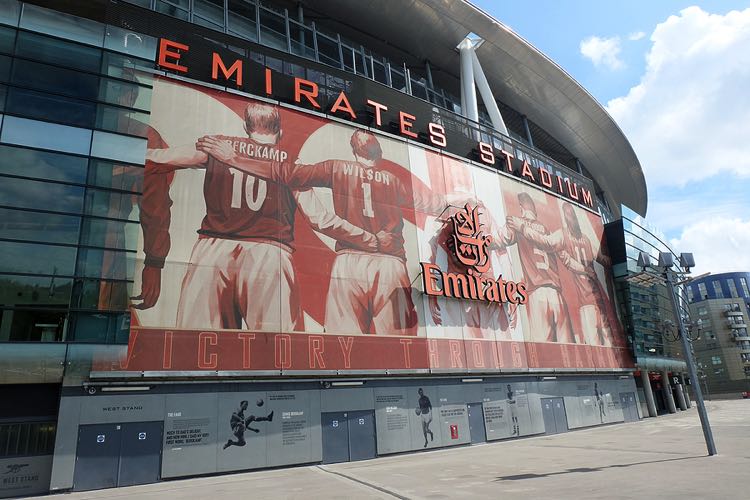Ashburton Grove, known since it was first built as the Emirates Stadium due to sponsorship (and sometimes called the Arsenal Stadium in UEFA competitions), has been the home of Arsenal FC since the 2006/07 season.
It is an ultra-modern ground, replete with some of the most extensive hospitality options in the world and boasts an enormous capacity of 60,704, which makes it the fourth biggest football stadium in the country. We will explore who owns it, how much it cost to build and the entire construction timeline.
History of the Emirates
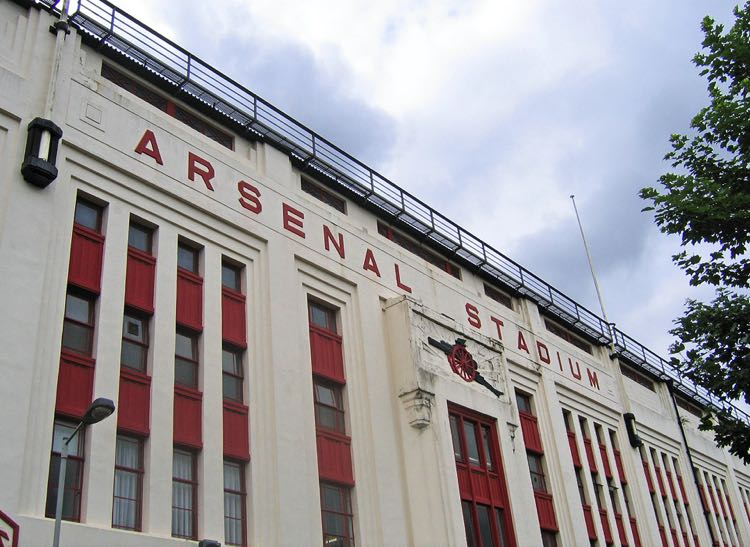
As we have discussed in other articles, Arsenal have had various names in their history and they have also played at a number of different locations. However, they are most associated with their home for almost 100 years, Highbury, where they moved in 1913.
Interestingly, Highbury was officially the Arsenal Stadium, though few ever referred to it as such. It held more than 60,000 fans in the earlier days of standing and 57,000 even into the early 1990s. It was an attractive, classic English football stadium, so why did the Gunners decide to move?
What Led to Arsenal Move Locations?
After tragic incidents, such as the Hillsborough disaster and the Bradford City stadium fire, there was an increased focus in English football on the potential dangers of standing terraces, especially in packed grounds. The Taylor Report, which investigated the Hillsborough disaster, recommended that stadiums should begin to remove their terraces in favour of seats, to prevent further disasters from occurring.
The Football Spectators Act was therefore amended in 1990, in line with the conclusion of the Taylor Report, to declare that it would be compulsory for Premier League and Championship clubs to have all-seater stadiums in time for the opening weekend of the 1994/95 season. For many teams, including Arsenal, terraces had been an integral part of the stadium, able to hold a larger number of spectators than seated facilities would, and therefore providing an income boost through ticket sales.
The north London club struggled to raise finances to afford this conversion, especially as they didn’t want to compromise on both the club’s transfer budget and its traditions. The owners eventually decided to raise cash by selling long-term season tickets in the newly converted North Stand, using a bond scheme that cost between £1,000 and £1,500 per ticket, garnering criticism that the scheme may have prevented those that were less well-off from supporting the Gunners.
Trying to Make a “New” Highbury Work
Highbury was officially converted to an all-seater stadium in 1993, after renovation on the North Bank was completed, which cost around £20 million. This conversion transformed Highbury, reducing its capacity from 57,000 in 1990 to under 40,000 just three years later, which caused an immediate, potentially catastrophic drop in revenue. In order to combat this reduction in income from ticket sales, the club decided to increase matchday prices, but this was unsuccessful in dealing with the north London giants’ rising debts.
The club therefore began considering the possibility of moving to a larger ground, to compete with the other top teams in England. However, before looking elsewhere, Arsenal’s ownership decided to attempt to extend Highbury, thinking that they could rebuild it as a larger ground, with a capacity of 48,000. However, this proposal quickly encountered a number of problems. Firstly, the plan would have involved demolishing 25 houses around the ground, which was expectedly unpopular among local residents, especially if they were Spurs fans!
Not only this, but the East Stand of Highbury, an art deco structure built in 1936, became Grade II listed in 1997, making it even more difficult for the ground to undergo renovation. This led to the club deciding to scrap the plan, as they also declared that a capacity of 48,000 wouldn’t suffice.
Exploring Other Grounds
After being forced to abandon any hope of feasibly expanding Highbury, the north London club quickly looked for other options, starting by making an official bid to purchase Wembley Stadium in 1998. However, the FA opposed this offer, as they made the claim that it would harm England’s bid for the 2006 World Cup, which, of course, went to Germany anyway! Unlucky Gunners.
Arsenal were therefore forced to withdraw from their attempt to purchase the ground, although, as a consolation, the club were able to host their Champions League home games at Wembley during the 1998/99 and 1999/00 campaigns. Although they had a disappointing run in both, going out in the group stages, the hugely increased capacity that the national stadium offered demonstrated the potential profitability of building a larger stadium. The club were able to set their record attendance at Wembley, as 73,707 watched their group stage match against Lens in November 1998.
Initial Proposal for the Emirates
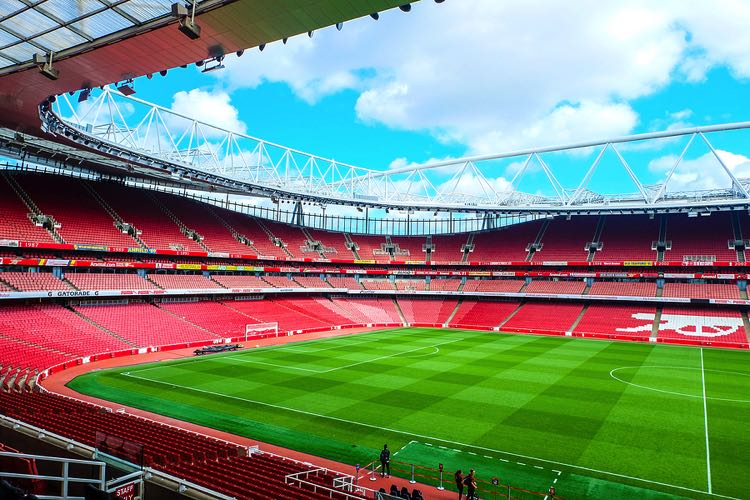
In 1999, Arsenal began exploring the possibility of constructing a new stadium in Ashburton Grove, an area that had been recommended by Anthony Spencer, the club property adviser, after he had searched all over north London for possible sites. The land also had the advantage of being near Highbury and was originally an industrial estate containing a rubbish-processing plant. Glamourous stuff!
The original planning application was submitted to Islington council in 2000, and was asking for a 60,000-capacity stadium, as well as converting the old Highbury ground into apartments and redeveloping nearby Drayton Park, a project that would supposedly create 2,300 new homes, along with 1,800 jobs for the local community. However, this planning application was initially met with resistance, with the Islington Stadium Communities Alliance forming an order to oppose the development of the new stadium, with a poll showing that 75% of local residents were against the plan.
However, despite this original distaste for the proposed development, around a year later, Arsenal launched a Christmas campaign, backed by Ken Livingstone, the Mayor of London, that declared “let Arsenal support Islington”, and this was hugely effective in smoothing any ill-feeling towards the new stadium. After this campaign, a poll found that 70% of the local population were now in favour, and the planning application was officially approved in December 2001.
How Did Arsenal Pay for the Stadium?
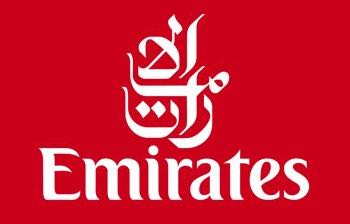 Although the Gunners were able to get over the first key hurdle, that being securing planning permission, they then were faced with the issue of: how on earth do we pay for the massive thing we have just asked for? This was especially problematic as they didn’t receive any sort of public subsidy from the government towards its construction, which is common in other countries, with manager, Arsène Wenger, frustratedly declaring that “Bayern Munich paid one euro for their stadium”.
Although the Gunners were able to get over the first key hurdle, that being securing planning permission, they then were faced with the issue of: how on earth do we pay for the massive thing we have just asked for? This was especially problematic as they didn’t receive any sort of public subsidy from the government towards its construction, which is common in other countries, with manager, Arsène Wenger, frustratedly declaring that “Bayern Munich paid one euro for their stadium”.
Selling Players
In comparison, the Gunners were forced to buy land in one of the priciest areas of London, purely with their own cash. They therefore had to raise income quickly. The first way that the club achieved this was through selling players, such as Marc Overmars and Emmanuel Petit, who were both sold to Barcelona, and Nicolas Anelka, who was sold to Real Madrid, with these transfers raising over £50 million towards the stadium.
Sponsorship Deals
Another way in which cash was raised was through sponsorship deals with corporations, such as Granada Media Group, who bought 5% of the club’s shares for £47 million. The club also extended their lucrative kit sponsorship with Nike too. Arsenal were also able to receive a £260 million loan from a number of banks, led by the Bank of Scotland, yet all of these efforts were unable to cover the cost of building the ground, which was estimated at £500 million.
However, the club’s fortunes changed as Emirates invested a massive £100 million in the stadium, which included purchasing its naming rights, securing funding for the new “Emirates Stadium”, as it became known. Such sponsorship deals were relatively common in other countries but far less so in England at the time, although where Arsenal and the Emirates led, many soon followed.
When Was the Emirates Built?
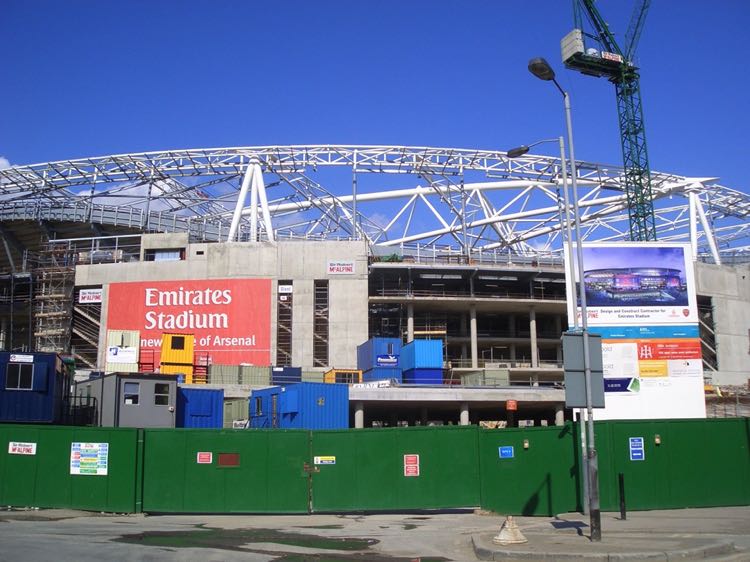
Once funding had eventually been secured, construction immediately began on the stadium, with its first stands completed in 2004. Power and water were then installed in 2005. In March 2006, the first seat was placed in the Emirates Stadium, done ceremonially by Arsenal midfielder, Abou Diaby, signifying the beginning of a new era for the Gunners.
By June, the goals had been installed, and the floodlights were up and running. By July 2006, the ground was ready, with the club hosting a number of “ramp-up” events, including an open training session on the new pitch, which selected club members could attend, and Dennis Bergkamp’s testimonial against Ajax.
On 26th October, 2006, the new Emirates Stadium was officially opened by Prince Phillip, standing in for the Queen, who was unable to attend due to illness. This invoked the official opening of Highbury’s West Stand in 1932, which was done by the Queen’s uncle, King Edward VIII. As she was unable to attend the ceremony itself, Her Majesty invited the club’s manager, chairman and first team to Buckingham Palace for afternoon tea, the first time a football team had attended such an event.
Do Arsenal Own the Emirates Stadium?

The Emirates Stadium is owned and managed by Arsenal Holdings plc, the parent company of Arsenal FC. This company is a subsidiary of Kroenke Sports & Entertainment, owned by American billionaire businessman, Stan Kroenke, and is used to manage his sports holdings.
These include NFL team, Los Angeles Rams, and NBA team, Denver Nuggets, alongside Arsenal FC and Arsenal W.F.C. Kroenke is the sole shareholder in Arsenal Holdings and is therefore the sole owner of the Emirates Stadium’s freehold, and the separate companies that maintain it and organise matchdays.

